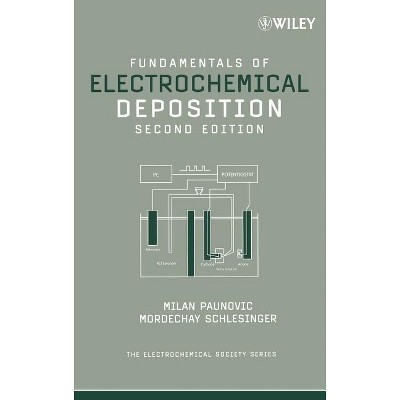Atomic-Scale Modelling of Electrochemical Systems - by Marko M Melander & Tomi T Laurila & Kari Laasonen (Hardcover)

About this item
Highlights
- Atomic-Scale Modelling of Electrochemical Systems A comprehensive overview of atomistic computational electrochemistry, discussing methods, implementation, and state-of-the-art applications in the field The first book to review state-of-the-art computational and theoretical methods for modelling, understanding, and predicting the properties of electrochemical interfaces.
- About the Author: Marko M. Melander, PhD, is a researcher and adjunct professor in physical (electro)chemistry at the University of Jyväskylä in the Department of Chemistry.
- 368 Pages
- Science, Chemistry
Description
About the Book
"Electrochemistry and electrocatalysis are at the forefront of many technological fields related to solving the grand challenges encountered in advanced energy solutions, personalized medicine, and environmental issues. Electrochemical technologies of interest include, among others, batteries, CO2 mitigation, various sensor technologies, water purification, molecular electronics, fuel-cells, hydrogen powered energies, and solar-powered renewable technologies. To improve upon existing electrochemical technologies in a rational way, understanding and controlling the atomic scale properties of the electrochemical interface is vital. In particular, the connection between atomic scale surface chemistry and the electrocatalytical performance needs to be established. Rational design of better electrocatalysts working in complex electrochemical environments needs insight from experiments, computational methods, as well as theoretical approaches. While experimental electrochemical and spectroelectrochemical methods are well-established and can often be routinely applied, theoretical and computational methods have not yet reached the same level of maturity. The lack of generally accepted and applicable computational and theoretical tools is due to the high complexity of the electrochemical interface which provides a number of challenges for atomic scale theory and modelling. Specific challenges include; (i) inclusion of the electrode potential, (ii) the need for several time and length scales to assess both thermodynamic and kinetic properties of the solid-liquid interface, and (iii) a quantum mechanical treatment to describe chemical bond making and breaking"--Book Synopsis
Atomic-Scale Modelling of Electrochemical SystemsA comprehensive overview of atomistic computational electrochemistry, discussing methods, implementation, and state-of-the-art applications in the field
The first book to review state-of-the-art computational and theoretical methods for modelling, understanding, and predicting the properties of electrochemical interfaces. This book presents a detailed description of the current methods, their background, limitations, and use for addressing the electrochemical interface and reactions. It also highlights several applications in electrocatalysis and electrochemistry.
Atomic-Scale Modelling of Electrochemical Systems discusses different ways of including the electrode potential in the computational setup and fixed potential calculations within the framework of grand canonical density functional theory. It examines classical and quantum mechanical models for the solid-liquid interface and formation of an electrochemical double-layer using molecular dynamics and/or continuum descriptions. A thermodynamic description of the interface and reactions taking place at the interface as a function of the electrode potential is provided, as are novel ways to describe rates of heterogeneous electron transfer, proton-coupled electron transfer, and other electrocatalytic reactions. The book also covers multiscale modelling, where atomic level information is used for predicting experimental observables to enable direct comparison with experiments, to rationalize experimental results, and to predict the following electrochemical performance.
- Uniquely explains how to understand, predict, and optimize the properties and reactivity of electrochemical interfaces starting from the atomic scale
- Uses an engaging "tutorial style" presentation, highlighting a solid physicochemical background, computational implementation, and applications for different methods, including merits and limitations
- Bridges the gap between experimental electrochemistry and computational atomistic modelling
Written by a team of experts within the field of computational electrochemistry and the wider computational condensed matter community, this book serves as an introduction to the subject for readers entering the field of atom-level electrochemical modeling, while also serving as an invaluable reference for advanced practitioners already working in the field.
From the Back Cover
A comprehensive overview of atomistic computational electrochemistry, discussing methods, implementation, and state-of-the-art applications in the field
The first book to review state-of-the-art computational and theoretical methods for modelling, understanding, and predicting the properties of electrochemical interfaces. This book presents a detailed description of the current methods, their background, limitations, and use for addressing the electrochemical interface and reactions. It also highlights several applications in electrocatalysis and electrochemistry.
Atomic-Scale Modelling of Electrochemical Systems discusses different ways of including the electrode potential in the computational setup and fixed potential calculations within the framework of grand canonical density functional theory. It examines classical and quantum mechanical models for the solid-liquid interface and formation of an electrochemical double-layer using molecular dynamics and/or continuum descriptions. A thermodynamic description of the interface and reactions taking place at the interface as a function of the electrode potential is provided, as are novel ways to describe rates of heterogeneous electron transfer, proton-coupled electron transfer, and other electrocatalytic reactions. The book also covers multiscale modelling, where atomic level information is used for predicting experimental observables to enable direct comparison with experiments, to rationalize experimental results, and to predict the following electrochemical performance.
- Uniquely explains how to understand, predict, and optimize the properties and reactivity of electrochemical interfaces starting from the atomic scale
- Uses an engaging "tutorial style" presentation, highlighting a solid physicochemical background, computational implementation, and applications for different methods, including merits and limitations
- Bridges the gap between experimental electrochemistry and computational atomistic modelling
Written by a team of experts within the field of computational electrochemistry and the wider computational condensed matter community, this book serves as an introduction to the subject for readers entering the field of atom-level electrochemical modeling, while also serving as an invaluable reference for advanced practitioners already working in the field.
About the Author
Marko M. Melander, PhD, is a researcher and adjunct professor in physical (electro)chemistry at the University of Jyväskylä in the Department of Chemistry. His work focuses on the development of theory and computational methodologies for studying (proton-coupled) electron transfer thermodynamics and kinetics at electrochemical interfaces.
Tomi T. Laurila, PhD is an Associate Professor in the Department of Electrical Engineering and Automation and Department of Chemistry and Materials Science at Aalto University in Finland where he leads the group of Microsystems Technology. The research focus of his group is on electrochemical properties of various carbon nanomaterials, computational materials science and applications of carbon nanomaterials in different sensing devices.
Kari Laasonen, PhD, is a Professor in the Department of Chemistry and Materials Science at Aalto University, Finland. He has been working on computational molecular modeling since the early 1990's. He has a strong background in ab initio molecular dynamics and modelling of aqueous systems, and his group started to model electrochemical reactions in early 2010, focusing on hydrogen and oxygen evolution reactions on different catalysts.
Shipping details
Return details
Trending Non-Fiction











